MARIANI’S
February 19, 2006
NEWSLETTER
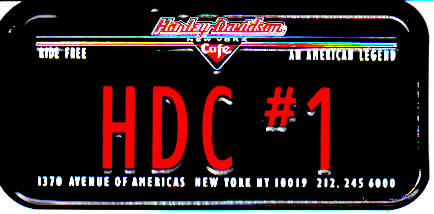
Harley-Davidson
Café, NYC (circa 2000)
~~~~~~~~~~~~~~~~~~~~~~~~~~~~~~~~
UPDATE: To
go to my web site, in which I will update food
&
travel information and help link readers to other first-rate travel
& food sites, click on: home page
ACCESS TO
ARCHIVE: Readers may now access
an
Archive of all past newsletters--each annotated--dating back to July,
2003, by simply clicking on www.johnmariani.com/archive
.
NEW
FEATURE! You may now subscribe anyone you wish
to this newsletter by
clicking here.
~~~~~~~~~~~~~~~~~~~~~~~~~~~~~~~~~
In
This Issue
NEW YORK CORNER: by John Mariani
QUICK BYTES
~~~~~~~~~~~~~~~~~~~
by John Mariani
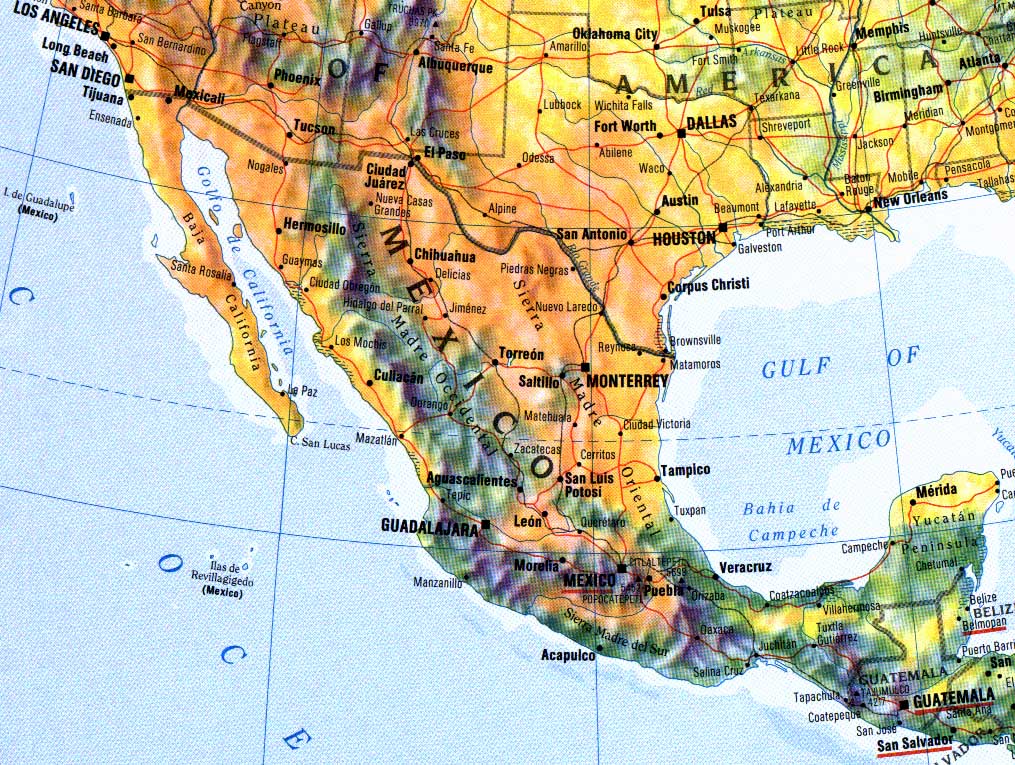 When
it comes to Mexican food, the
question of authenticity is a slippery slope: On the one
hand the
historic
underpinnings of the genre have
sacred
links to regional religion and culture. On
the other, all food, including Mexican, is constantly
evolving as
people trade with each other and adapt new ingredients and techniques
into
their cuisine. When you consider that Indian and Thai food had no chile
peppers
until well into the 17th century, and no Italian ever laid
eyes on a
tomato until it arrived from the Americas about the same time, you must
also
recognize that before the Spaniards arrived in Mexico there were no
pigs,
cattle, or chickens in the people’s diet. So the idea that dishes like
chicken
enchiladas, huevos rancheros, and carnitas are ancient Aztec
delicacies
is simply nonsense.
When
it comes to Mexican food, the
question of authenticity is a slippery slope: On the one
hand the
historic
underpinnings of the genre have
sacred
links to regional religion and culture. On
the other, all food, including Mexican, is constantly
evolving as
people trade with each other and adapt new ingredients and techniques
into
their cuisine. When you consider that Indian and Thai food had no chile
peppers
until well into the 17th century, and no Italian ever laid
eyes on a
tomato until it arrived from the Americas about the same time, you must
also
recognize that before the Spaniards arrived in Mexico there were no
pigs,
cattle, or chickens in the people’s diet. So the idea that dishes like
chicken
enchiladas, huevos rancheros, and carnitas are ancient Aztec
delicacies
is simply nonsense.Having once eaten at a restaurant in Mexico City named El Chon (160
Purists are always on shaky ground when defending “traditional” Mexican food, especially since Mexico has 32 regions, each with its own special dishes. I happily yield to the authorities on the subject--writers like Diana Kennedy, Zarela Martínez, Rick Bayless, and Patricia Quintana, although each of them can disagree with each other as to what exactly constitutes authenticity (blood has been spilled on these issues). And, no, no, no, I don't find a thing wrong with traditional Mexican food as it's cooked and served in restaurants in Mexico City, which some would say is far too refined.
Those I find truly risible, however, are the blind zealots who cannot distinguish among the wholly mediocre, the patently average, and the appealingly good Tex-Mex restaurants in the Lone Star state, a legitimate enough genre all its own but one that has unfairly defined most Mexican food outside of Texas as consisting of combo platters, taco chips,
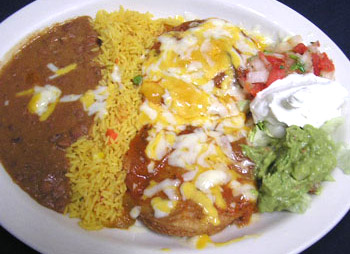 yellow cheese, and fried ice cream.
Everybody loves the stuff, it's good grub, and it's always cheap.
Nevertheless there are those self-appointed keepers of the true Tex-Mex
flame who can go on for hours
about the distinction among fifty different eateries in El Paso all
serving the
same ten dishes made, by necessity, from the same cheap
ingredients. One Houston newspaper scribbler is forever
blathering on, week after week, about how "the
creamy refried pinto beans and home-style fried potatoes on either side
of them were awesome" in yet another greasy griddle while exalting the
virtues of Velveeta,
containers of sour cream, bags of yellow rice, canned sweetened
condensed milk, and cheap tequila, lamenting that the real flavors of
such supermarket ingredients don't translate beyond the Oklahoma
border. And any cook that seeks to use better ingredients and cook
them with flair is labeled "yuppified." Whatever.
yellow cheese, and fried ice cream.
Everybody loves the stuff, it's good grub, and it's always cheap.
Nevertheless there are those self-appointed keepers of the true Tex-Mex
flame who can go on for hours
about the distinction among fifty different eateries in El Paso all
serving the
same ten dishes made, by necessity, from the same cheap
ingredients. One Houston newspaper scribbler is forever
blathering on, week after week, about how "the
creamy refried pinto beans and home-style fried potatoes on either side
of them were awesome" in yet another greasy griddle while exalting the
virtues of Velveeta,
containers of sour cream, bags of yellow rice, canned sweetened
condensed milk, and cheap tequila, lamenting that the real flavors of
such supermarket ingredients don't translate beyond the Oklahoma
border. And any cook that seeks to use better ingredients and cook
them with flair is labeled "yuppified." Whatever.Fortunately, a young generation of chefs, both in Mexico and in the U.S., has been transforming Mexican cuisine--cookery, if you like--in subtle and not-so-subtle ways, while maintaining strong links to culinary tradition out of true respect and affection for the food.
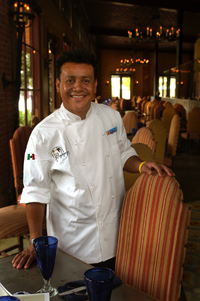 You would, of course, expect wonderful traditional
Mexican food in Houston, but, oddly
enough,
there are few restaurants polishing and updating the image of the genre
as does Hugo’s (1602 Westheimer; 713-524-7744; click) where
overcooked enchiladas
and yellow cheese are nowhere in sight. What
you will find is a menu of delicious dishes like
seasoned crab tostadas, a fat
ancho
pepper stuffed with chorizo and potatoes; gorditas
with shredded rabbit; tamales stuffed with red snapper; and a sopa teeming
with nice fresh shellfish--something you’d be hard put to find at your
local
Tex-Mex joint.
You would, of course, expect wonderful traditional
Mexican food in Houston, but, oddly
enough,
there are few restaurants polishing and updating the image of the genre
as does Hugo’s (1602 Westheimer; 713-524-7744; click) where
overcooked enchiladas
and yellow cheese are nowhere in sight. What
you will find is a menu of delicious dishes like
seasoned crab tostadas, a fat
ancho
pepper stuffed with chorizo and potatoes; gorditas
with shredded rabbit; tamales stuffed with red snapper; and a sopa teeming
with nice fresh shellfish--something you’d be hard put to find at your
local
Tex-Mex joint.The main courses at Hugo's are lavish and include a very juicy and delicious roasted rabbit with guajillo adobo, purple sweet potatoes and jicama salad, the tang of lime juice cutting the richness of the dish. Roast duck comes with a red mole sauce, and pork is stewed in a casserole with chayote, and green and white beans in a green mole.
Much of Hugo’s appeal is the delightful story behind it: Chef-owner Hugo Ortega (above) has lived out his American dream beyond all expectations, having arrived here as a teenager, working as a dishwasher, then a busboy, then a line cook, before earning a culinary degree. He married Tracy Vaught and together they opened the well-regarded Backstreet Café and Prego. But at Hugo’s, located in a large 1925 commercial building with plenty of fine old brickwork, he has made his mark by featuring the regional cooking of Mexico. Here, proudly, he makes his own queso fresco cheese and chorizo, grinds his own corn, and roasts its own coffee beans. His brother Ruben makes some of the very best desserts anywhere in the U.S.-- capirotada (Mexican bread pudding with cane syrup, queso fresco ice cream and crushed peanuts), churros stuffed with dulce de leche and served with Mexican hot chocolate with chocolate ice cream, and a chocolate flan with kumquat sauce, cajeta cream and an amaranth cookie.
Add to all this an extremely extensive wine list, great margaritas (above) and you have a very special restaurant in the forefront of modern Mexican cuisine. But you don't have to be Texan to make terrific new-style Mexican food.
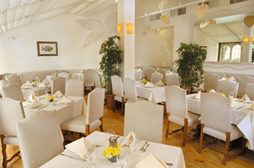
One of the most exciting Mexican restaurants to have opened in the past year is Pampano (209 East 49th Street; 212-751-4545; click ) in New York, a labor of love of restaurateur/chef Richard Sandoval, whose Maya Grills in New York and San Francisco certainly push the envelope of style with colorful presentations and artful use of ingredients. Pampano goes further, not by retreating from Mexican traditions but by refining them in exquisite ways with superb ingredients. The fact that Spanish tenor Placido Domingo owns the restaurant hasn’t hurt its success either.
Here, in a spacious, two-level restaurant (right) done in sandy colors and fine Mexican artwork, you will delight in dishes like lamb braised in a banana leaf, a cornmeal tamal stuffed with wild mushrooms and a lobster-shrimp sauce, pan-fried whole baby red snapper with cactus salad and a chile de arbol sauce, and desserts like cajeta custard with caramelized bananas. None of these dishes betrays Mexican tradition; all make it brighter.
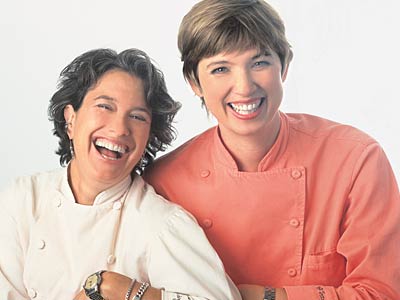 Ironically,
many of the most exciting “Nuevo” Mexican restaurants are not run by
Mexicans,
or even Latinos.
Ironically,
many of the most exciting “Nuevo” Mexican restaurants are not run by
Mexicans,
or even Latinos.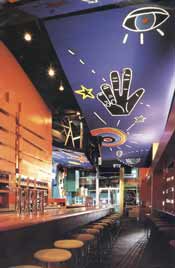 Two pioneers of the new movement are Mary Sue Milliken
and
Susan Feniger (left), who
opened the Border Grill (right) back in 1985 in Los
Angeles
and moved it to Santa Monica (1445 Fourth Street; 310-451-1655; click ) five years
later, now with
a branch in Las Vegas. Los Angeles
Magazine went so far as to call The Border Grill “arguably the most
serious
Mexican food in town,” and I couldn’t agree more when faced with dishes
like
their bocaditos (“little bites”) of tuna amarillo ceviche, and
wild
mushroom quesadillas with epazote, garlic and cheese. Then you move on to main courses like an
adobo pork chop brined in cinnamon, cooked to a turn and served with an
apple-tamarind sauce, glazed carrots, mashed boniato, and chile dulce—a
masterful blend of ingredients as fresh as they are modern. They also slowly braise pork with Serrano
chilies, red onion and cilantro, then serve it with citrus slaw, and
grilled
turkey comes with a coarsely cracked pepper sauce, mashed yams drizzled
with
lime, and seared greens. Finish with an
Aztec chocolate cake with spiced pecans.
Two pioneers of the new movement are Mary Sue Milliken
and
Susan Feniger (left), who
opened the Border Grill (right) back in 1985 in Los
Angeles
and moved it to Santa Monica (1445 Fourth Street; 310-451-1655; click ) five years
later, now with
a branch in Las Vegas. Los Angeles
Magazine went so far as to call The Border Grill “arguably the most
serious
Mexican food in town,” and I couldn’t agree more when faced with dishes
like
their bocaditos (“little bites”) of tuna amarillo ceviche, and
wild
mushroom quesadillas with epazote, garlic and cheese. Then you move on to main courses like an
adobo pork chop brined in cinnamon, cooked to a turn and served with an
apple-tamarind sauce, glazed carrots, mashed boniato, and chile dulce—a
masterful blend of ingredients as fresh as they are modern. They also slowly braise pork with Serrano
chilies, red onion and cilantro, then serve it with citrus slaw, and
grilled
turkey comes with a coarsely cracked pepper sauce, mashed yams drizzled
with
lime, and seared greens. Finish with an
Aztec chocolate cake with spiced pecans.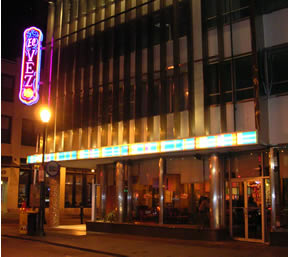 I hesitated for a moment
to put El
Vez (121
South 13th Street; 215-928-9800; click) in Philadelphia into
this article because the look of
the place
may not strike you as a "serious" Mexican restaurant.
For one thing, there’s a gilded low-rider
motorcycle above the bar, plenty of neon, and hundreds of little boxed
containing Day of the Dead skeletons. The
margaritas flow like water, and the place is louder
than a
bullfight.
I hesitated for a moment
to put El
Vez (121
South 13th Street; 215-928-9800; click) in Philadelphia into
this article because the look of
the place
may not strike you as a "serious" Mexican restaurant.
For one thing, there’s a gilded low-rider
motorcycle above the bar, plenty of neon, and hundreds of little boxed
containing Day of the Dead skeletons. The
margaritas flow like water, and the place is louder
than a
bullfight. 
There are six different salsas to choose from, including shrimp with black beans and poblanos, cactus and crab with cilantro, and spicy tuna with pineapple and habaneros, all served with fresh tortillas. There is a Yucatan pork tamale with charred tomatillo-jalapeno salsa and cebolla criolla, and one dish I’ve never seen in a Mexican restaurant—duck confit flautas with poblano-avocado sauce, cotija cheese, and crema fresca. Also recommended is slowly cooked spiced lamb wrapped in banana leaves and served with frijoles charros. For dessert a little cup of mocha is topped with Kahlua foam and a crisp espresso wafer, while cheesecake incorporates white chocolate and mango and a gelée of blood orange and ancho chili syrup, with candied mango on the side.
The best thing about such dishes in these restaurants is their taste, which is modern, zesty, and always based on the best ingredients. That they also do nothing to betray Mexican culinary traditions is proof that what was truly wonderful in the past can be made even better by the chefs of the present and future.
NEW YORK CORNER by John Mariani
Alfama
551 Hudson Street
212-645-2500
www.alfamarestaurant.com
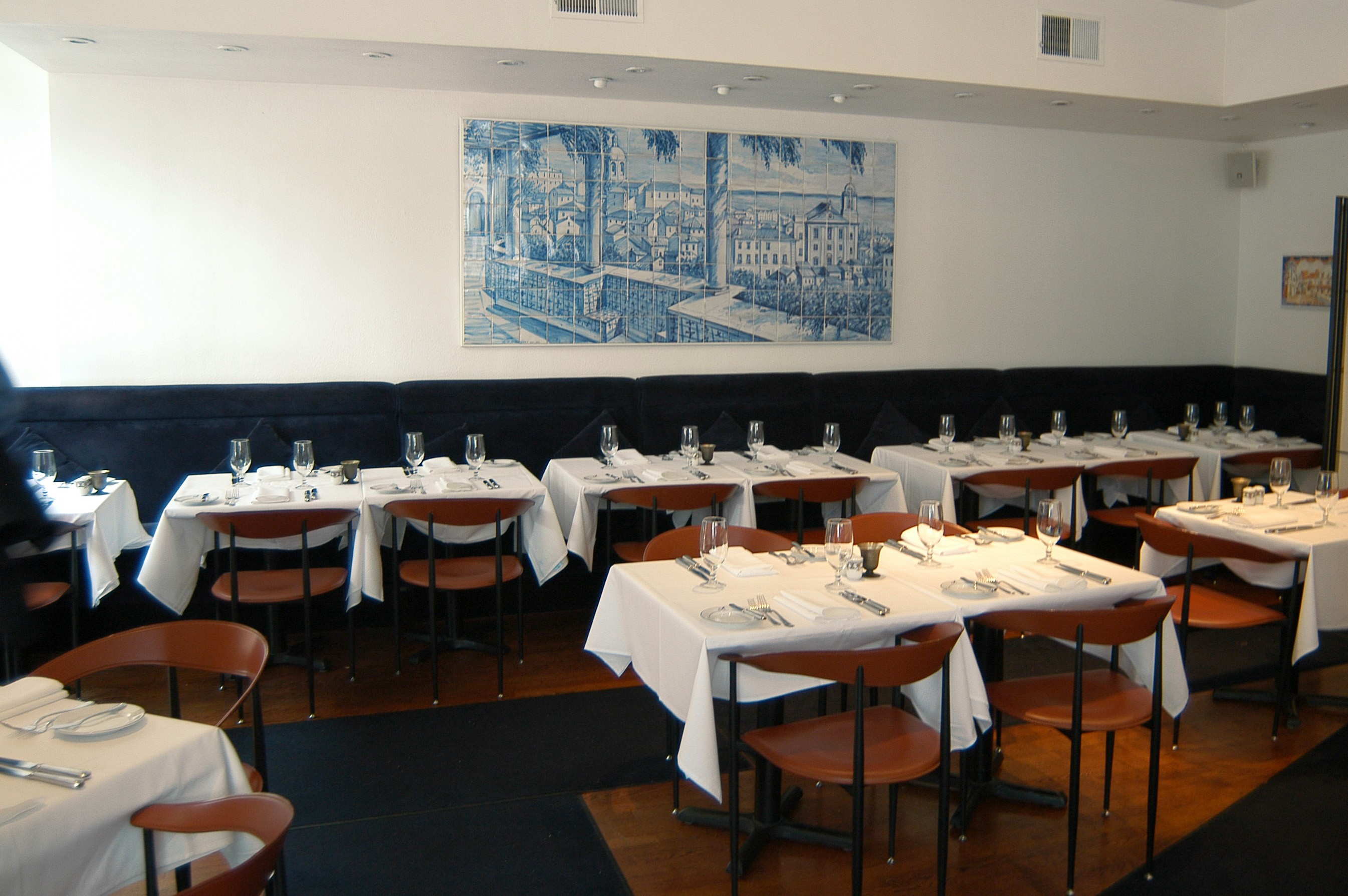 Portuguese
food is not well represented in New York, although across the
Hudson River in Newark, NJ, there is a thriving Portuguese community
with plenty of places featuring traditional food of the Levant. Just
how good they are, I'm afraid I can't tell you.
Portuguese
food is not well represented in New York, although across the
Hudson River in Newark, NJ, there is a thriving Portuguese community
with plenty of places featuring traditional food of the Levant. Just
how good they are, I'm afraid I can't tell you.The one truly bright star in Manhattan, however, set charmingly on the corner of Hudson and Perry Streets in Greenwich Village, is Alfama, which for five years now has not just succeeded but grown better and better under partners Miguel Jerónimo and Tarcisio Costa.
It has not been easy, though Alfama has found its niche with those who 1. Love authentic and imaginative Portuguese food, 2. find Alfama one of the most neighborly of restaurants, 3. want to know the best Portuguese wines now coming into the U.S., and, 4. on Wednesday nights, come to hear the live soul music of Portugal called fado. Were I in New York every Wednesday, this is where I'd be, bracing myself for the power and charisma of two marvelous Portuguese vocalists--Elizabeth Maria and Cora d'Abrue--who bring lifetimes of intimacy with the genre of fado, which can be very sad, like the blues, or exultant, like an operatic aria. Accompanied by two fine guitarists within the coziness of this small L-shaped room, the singers fill the space with swooping almost wailing music, without benefit of microphones, with their husky, romantic outpourings of emotional intensity. (There is also jazz on Thursdays.)
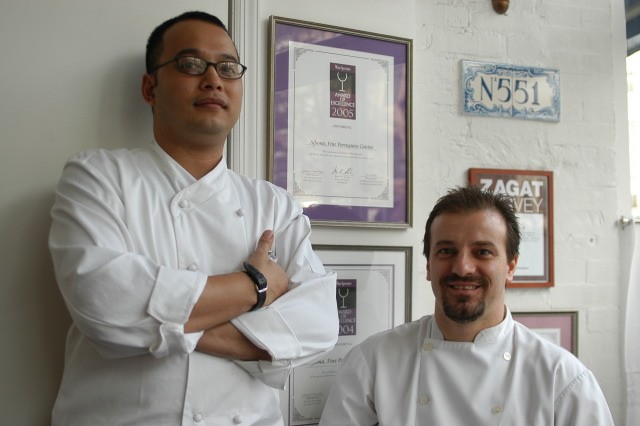
And what of the food? It is better than ever, now in the hands executive chef Luis Caseiro (right in photo) and a new young chef de cuisine, Dan Obusan (left), who have been able to demonstrate their acumen with tradition while refining the food along the lines of what you will find in the newer restaurants of Lisbon.
Alfama takes its name from the maze-like neighborhood of the same name on one of Lisbon's seven hills in the oldest part of the city, with a distinctive Moorish influence in the architecture, food, and music of the area, which in recent years has become remarkably trendy among young Portuguese. The blue-and-white tiles of the sector are well presented at the New York restaurant, which already had a beautiful 1900 Romanesque-style façade that has been carefully restored and fits the style perfectly. Paintings by well-known Portuguese artists Eduardo Alarcão and Isabel Pavão add luster to the 50-seat room (tables are set outside in spring) with a convivial bar up front where you can sit and enjoy one of Alfama's signature cocktails or choose from a winelist chosen by Mr. Costa to be what is probably the best representatives in the U.S. of modern Portuguese viniculture, with more than 100 wines (and a Wine Spectator Award of Excellence), with 18 selections by the glass, 50 Ports and 10 Madeiras by the glass.
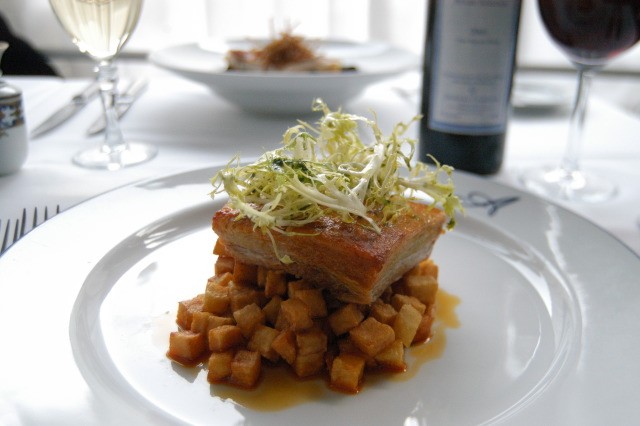 The menu items are cordially explained in
English, which may range from a traditional first course (entrada) like ovos mexidos com farinheira, which is a dish of fluffy scrambled eggs
and diced tomatoes with a Portuguese pork-and-flour sausage to desserts
like sericaia, a baked custard from
The menu items are cordially explained in
English, which may range from a traditional first course (entrada) like ovos mexidos com farinheira, which is a dish of fluffy scrambled eggs
and diced tomatoes with a Portuguese pork-and-flour sausage to desserts
like sericaia, a baked custard from Equal largess is shown in every main course, which are broken into "Alfama classics," "Traditional Portuguese Cuisine," and new dishes. One of the best of the last is marvelously rich but not heavy slow-braised Niman Ranch pork belly (above) served with crispy brunoise potatoes and fresh clams in a white wine and bell pepper paste sauce. The gratinéed salt cod called bacalhau espiritual (right) is indeed imbued with an intensity that might
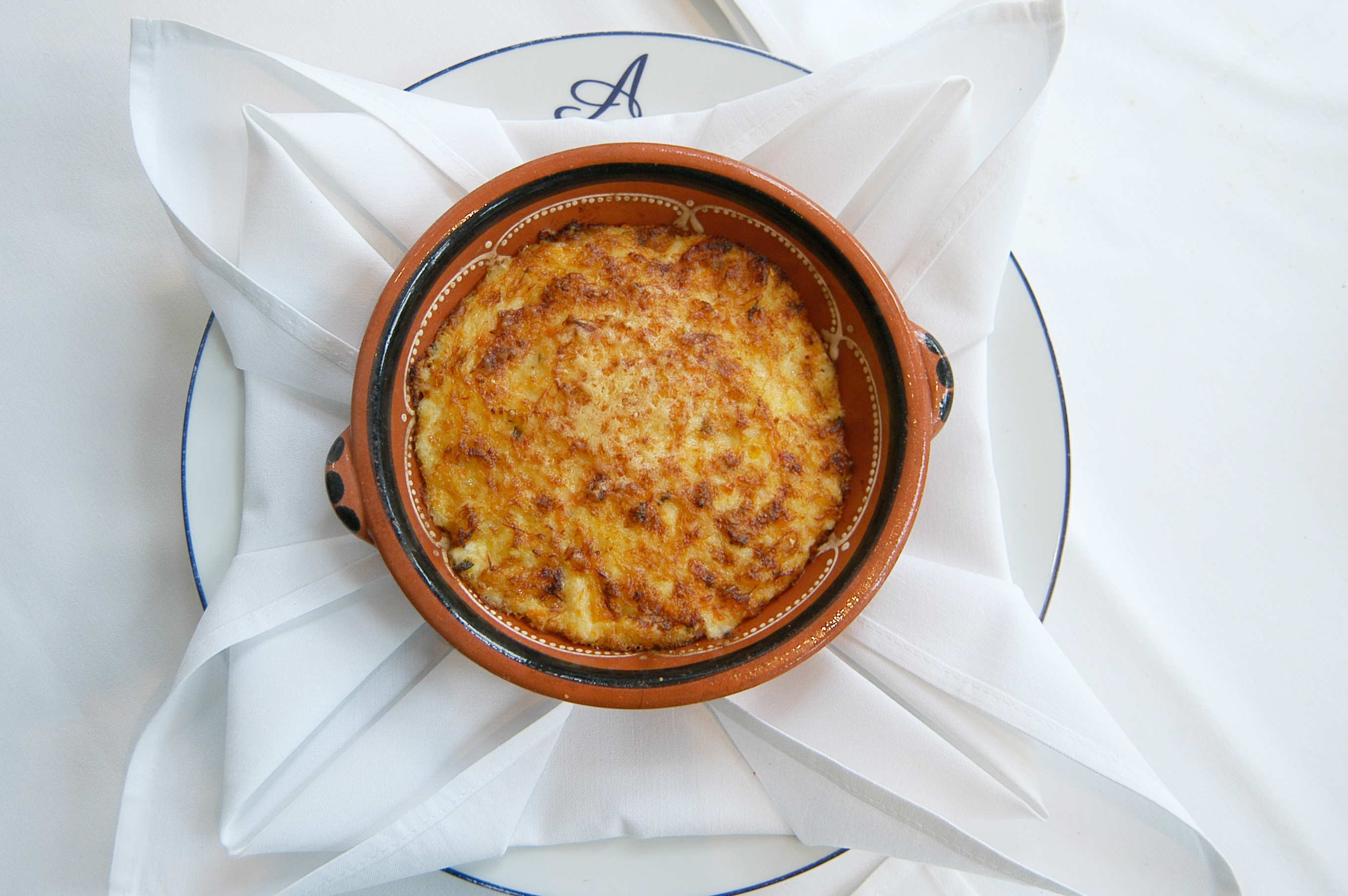 well cause a spiritual revival for
Portuguese cooking, while gambas
grelhadas com Piri-Piri are simply,
an impeccably, grilled Mozambican
jumbo prawns rubbed in hot and spicy chile sauce tamed by being
served over caramelized pineapple. Pato com
canela is very
tender but crisp Moulard duck
leg served with a nutmeg-infused potato gratin and frisée
in a
Port-cinnamon reduction that hints as much of North Africa and Macau as
it does of Portugal. If you want fish go with either the robalo exótico, seared sea bass served over
gingered yams and fresh arugula in a star anise-infused sauce, or pargo salteado com
Açafrão e alho francês, pan-seared red snapper fillet
served in a saffron mussel sauce and crispy leeks
well cause a spiritual revival for
Portuguese cooking, while gambas
grelhadas com Piri-Piri are simply,
an impeccably, grilled Mozambican
jumbo prawns rubbed in hot and spicy chile sauce tamed by being
served over caramelized pineapple. Pato com
canela is very
tender but crisp Moulard duck
leg served with a nutmeg-infused potato gratin and frisée
in a
Port-cinnamon reduction that hints as much of North Africa and Macau as
it does of Portugal. If you want fish go with either the robalo exótico, seared sea bass served over
gingered yams and fresh arugula in a star anise-infused sauce, or pargo salteado com
Açafrão e alho francês, pan-seared red snapper fillet
served in a saffron mussel sauce and crispy leeksAlfama also offers a splendid selection of Portuguese cheeses (below) rarely seen here, including Queijo de Évora
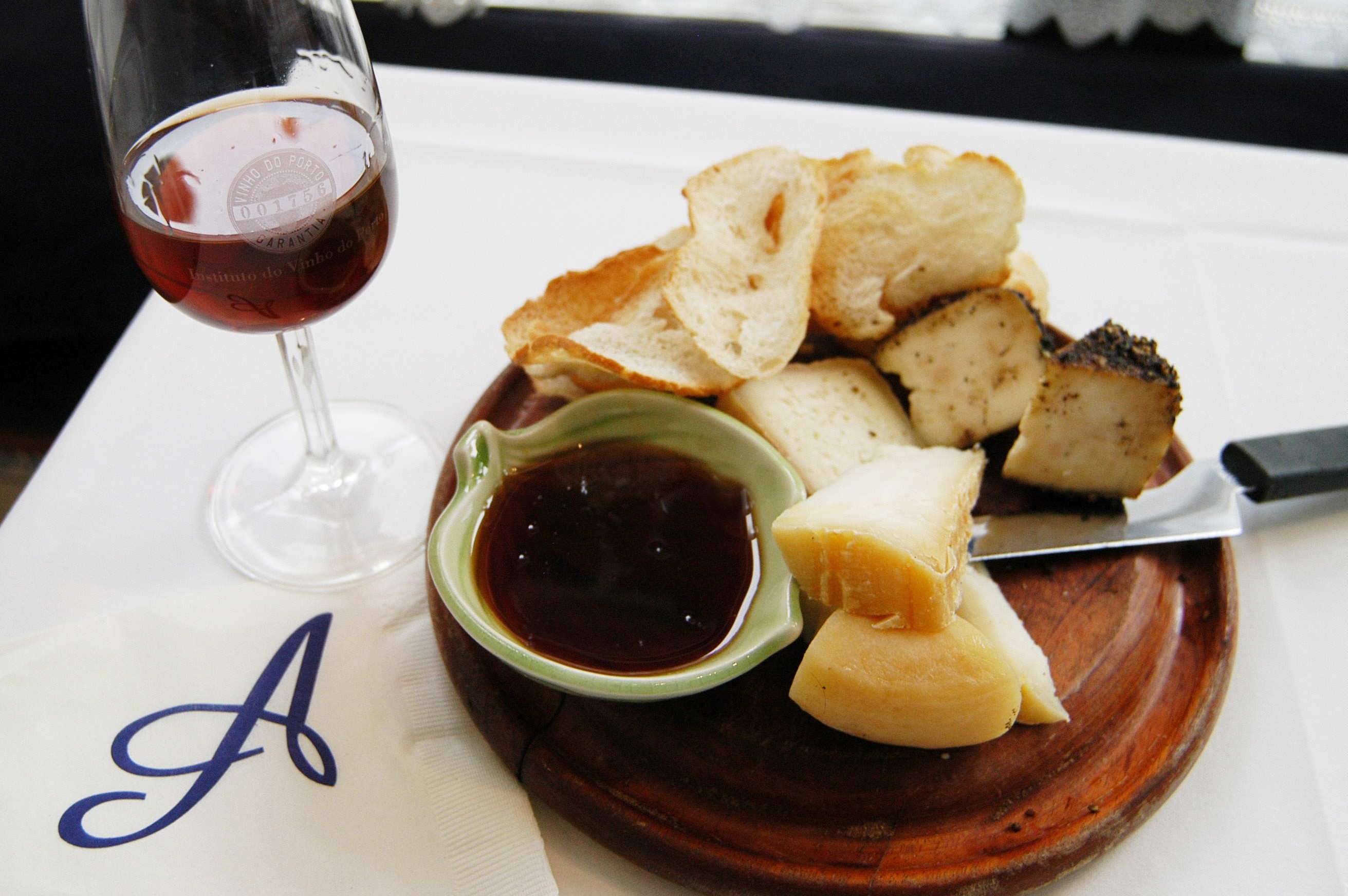 Desserts do not quite come up to the new
refinement of the food here, but you cannot fail to be happy with
sweets like creme queimado com
infusão de chá de tília, a crème brûlée infused with nettle tea;
alperces
Flambeados com Gelado de Morangos, fresh apricots
flambéed in Grand Marnier and served with
strawberry ice cream; or
Desserts do not quite come up to the new
refinement of the food here, but you cannot fail to be happy with
sweets like creme queimado com
infusão de chá de tília, a crème brûlée infused with nettle tea;
alperces
Flambeados com Gelado de Morangos, fresh apricots
flambéed in Grand Marnier and served with
strawberry ice cream; or Were Alfama only a charming corner store-front eatery in Greenwich Village, it would be a pretty place to go for good food and drink. But it is significantly more than that in being New York's premier Portuguese restaurant and a place most of us can learn a good deal from about this marvelous gastronomic culture while absorbing the pathos and joy of fado.
NOTES FROM THE WINE CELLAR
The fact that Kendall-Jackson is still a family-owned and operated business in a California wine world where conglomeration is sadly becoming the rule makes former attorney Jess Jackson’s achievements all the more remarkable. Just at the time
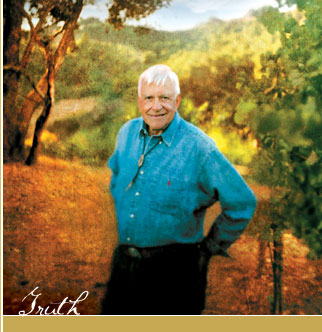 Since then Jackson
(semi-retired but
still CEO of the company) has gone on to buy up vast plots of vineyard
land--12,000
acres—in Napa, Sonoma, Mendocino, Santa Barbara and Monterey
California, incorporating
24 prestigious wineries like Edmeades, La Crema, Pepi, Stonestreet, and
Camelot, as well as Calina in Chile and Yangarra in Australia. In 2002
the
winery was named winner of the Stratospheric Ozone Protection Award by
the U.S.
Environmental Protection Agency for having “made significant
contributions to
protecting the environment.”
Since then Jackson
(semi-retired but
still CEO of the company) has gone on to buy up vast plots of vineyard
land--12,000
acres—in Napa, Sonoma, Mendocino, Santa Barbara and Monterey
California, incorporating
24 prestigious wineries like Edmeades, La Crema, Pepi, Stonestreet, and
Camelot, as well as Calina in Chile and Yangarra in Australia. In 2002
the
winery was named winner of the Stratospheric Ozone Protection Award by
the U.S.
Environmental Protection Agency for having “made significant
contributions to
protecting the environment.”“If I had nothing but Kendall-Jackson wines on my list, I’d still sell a lot of wine,” says Alex Brennan-Martin, owner of Brennan’s of
“I’m all for carrying popular brands if the quality is there,” says Kathy Trustman, owner The Metropolitan Club steak house in
Ironically, most people in the wine business I spoke with credited Kendall-Jackson with making good wine for good value (the entry level Vintner’s Reserve wines retail for $11-$16). And many think highly of Kendall-Jackson’s new boutique labels. “We do carry their Camelot Chardonnay at Nobu [in NYC],” says wine director David Gordon, who also oversees the 1,800-label list at Tribeca Grill but carries none of the Kendall-Jackson wines. “I think it’s well made and well priced. But I’m hired to find wineries our guests may not have heard of, and having Kendall-Jackson on the list would diminish it.”
High volume works against Kendall-Jackson’s image. “As a wine director I lean towards smaller boutique wines as opposed to what people drink all the time,” says Brian Duncan of
Kendall-Jackson’s entry into the higher-tier market meant playing down the family name, usually in small print on the new labels for
My favorite among the new wines is their Seco Highlands Pinot Noir 20003 ($30) made in
I was also impressed with the Alisos Hills Syrah 2002 ($30) from
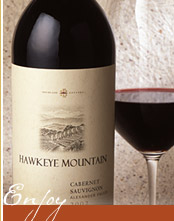
Balance was also key in the Hawkeye Mountain Cabernet Sauvignon 2002 ($45) from
There wasn’t much to balance out, however, in the one-dimensional Taylor Peak Merlot 2002 ($35) from
I was more disappointed in the two chardonnays I sampled. Camelot Highlands Chardonnay 2003 ($25) from
So, too, the Kendall-Jackson Chardonnay Grand Reserve ($20), made from grapes from Monterey, Santa Barbara, and Sonoma counties, was as the company’s winemaster, Randy Ullom, describes it in his notes: “Lush and tropical with bright citrus notes and ripe apple flavors.” But that, for me, is the problem; the wine tastes more like tropical fruit juice than an elegant chardonnay. After one glass as an aperitif, I had no interest in drinking another, unless I was having cayenne-dusted shrimp with a mango salsa and coriander on the side.
I applaud Kendall-Jackson for demonstrating how well it can compete with the boutique wineries at the $20+ level. I also understand that the Kendall-Jackson style of chardonnay put them where they are. With a little more finesse in the chardonnay and some patience with aging the reds, I think these are wines that will figure into any respectable wine list in the future.
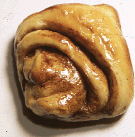 CAN'T
THEY JUST BAKE UP ANOTHER ONE?
CAN'T
THEY JUST BAKE UP ANOTHER ONE?THEN HAVE A
NICE CHAT WITH
YOUR PSYCHIATRIST
QUICK BYTES
* Domaine Chandon Winery and restaurant in the Napa Valley will host a series of wine dinners with local vintners: Feb. 26 : Domaine Chandon, with Tom Tiburzi, Winemaker; March 26: Domain Chandon with James Kress, Winemaker, "A Passion for Pinot"; April 30: Domaine Chandon with Rick Aldine, Director of Winegrowing,"Sustainable Winegrowing"; May 21: Newton Vineyrad with Stephen Carrier, Winemaker, "Beauty with Age"; $95 pp paired with wine or $65 without wine pairings. Call 800-736-2892, or visit www.opentable.com
* On March 1, Opera Diva Victoria Baker joins creative forces with Jean-Louis Gerin at Restaurant Jean-Louis in
* From March 2-5 the Distinctively Charleston Food and Wine Festival will showcase the cuilinary soul of the city with cooking demos by American chefs, authors, and wine professionals in more than 45 events incl. wine seminars, cooking demonstrations, tastings, dinners and parties, a gospel brunch and more. Southern Wine & Spirits will present a “Restaurant Dine Around” with chefs featured in Area Restaurants, incl. Charleston Place, Circa 1886, Cypress, FIG, Oak Steakhouse, McCrady’s, Peninsula Grill, Sea Island Grill, Sienna, Slightly North of Broad and Tristan, and the Dining Room at Woodlands. The Gala Finale on Sat. March 4, Presented by Wild American ShrimpLive Auction Benefiting the Culinary Institute of Charleston, will incl. an auction. On Sunday a Low Country Gospel brunch will be held at Lowndes Grove Plantation to benefit Slow Food Charleston. For schedules, tickets and information on hotel packages, visit www.charlestonfoodandwine.com or call (866) 369-3378.
* On March 6 Chef Jimmy Bannos of Heaven on Seven in
* On March 7, Roy's San Francisco will host a South African Winelands 5-course dinner featuring a fusion of foods and wines. $85 pp, Call
* On March 12 Mary Ann Esposito, host of the PBS series “Ciao Italia,” will be the guest of honor at a 4-course wine dinner at Costantino's Ristorante on Federal Hill in Providence, RI. An autographed copy of Esposito's latest book, Ciao Italia Pronto, will be given to every couple that attends. the dinner. A different wine will be served with each course as recommended by Mark Gasbarro of Gasbarro Liquors on Federal Hill. $85 pp. Call 401-528-1100.
~~~~~~~~~~~~~~~~~~~~~~~~~~~~~~~~~~~~~~~~~~~~~~~~~~~~~~~~~~~~~~~~~~~~~~~~~
MARIANI'S VIRTUAL GOURMET NEWSLETTER is published weekly. Editor/Publisher:
John Mariani. Contributing Writers: Robert Mariani, Naomi
Kooker, Kirsten Skogerson, Edward Brivio, Mort
Hochstein, Suzanne Wright. Contributing
Photographers: Galina Stepanoff-Dargery, Bobby Pirillo. Technical
Advisor: Gerry McLoughlin.
Any of John Mariani's books below
may be ordered from amazon.com by clicking on the cover image.
 |
 |
 |
 |
 |
 |
copyright John Mariani 2006